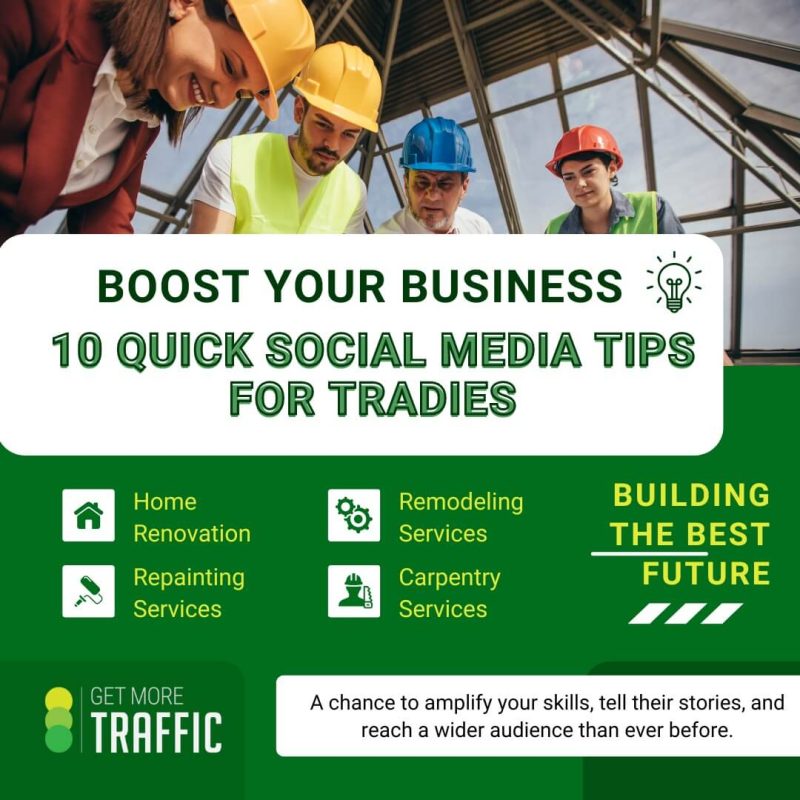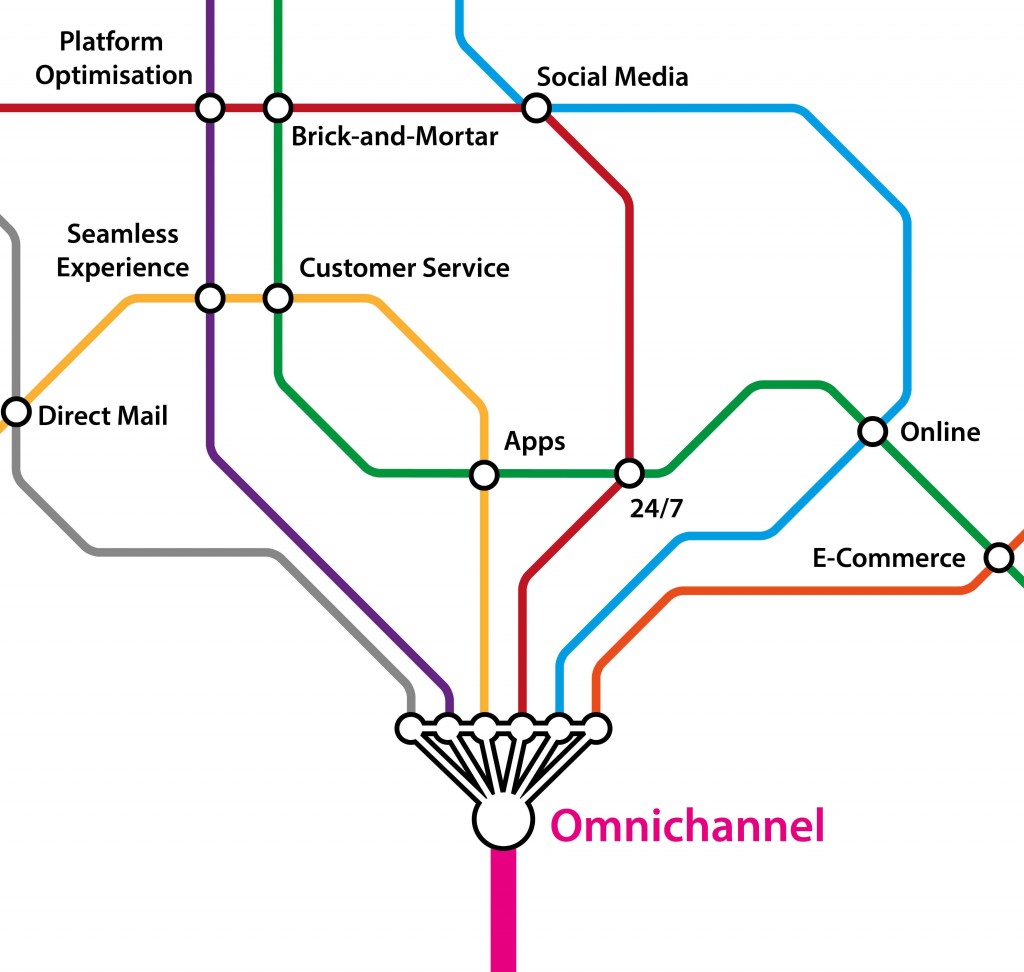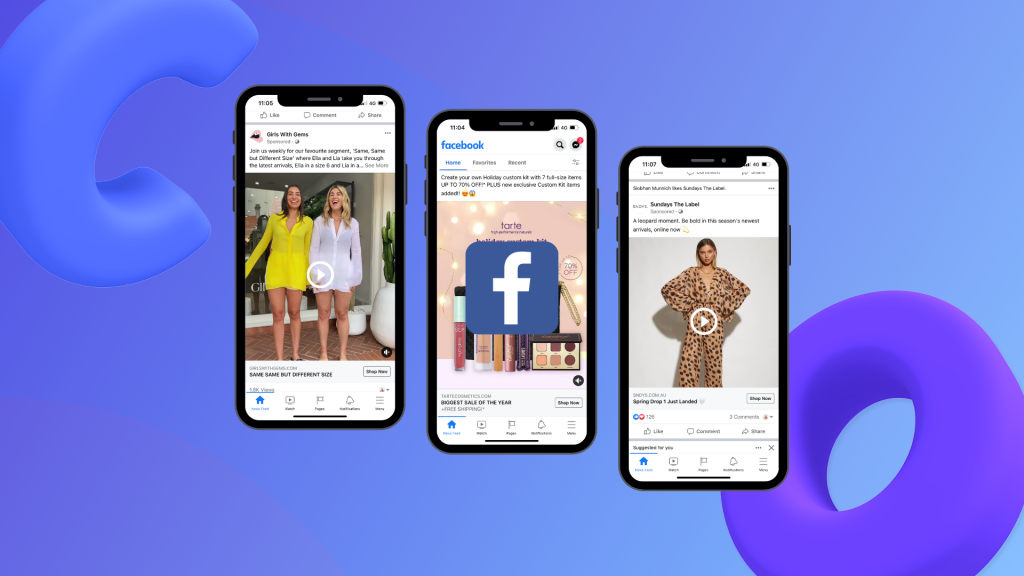Boost Your Business: 10 Quick Social Media Tips for Tradies
Quick Social Media Tips for Tradies
In this modern world, social media has become more than just a way to connect; it’s a powerful tool that can transform businesses and careers. For tradies, harnessing the potential of social media marketing is a game-changer. It means to showcase their craftsmanship, engage with clients, and take their businesses to the next level.
Platforms like Facebook, Instagram, and LinkedIn offer tradies the chance to amplify their skills, tell their stories, and reach a wider audience than ever before. With every post, image, and interaction, tradies can build a brand that stands out and creates lasting impressions.
This guide delves into the essentials of social media marketing for tradies. From choosing the right platforms to crafting compelling content, we’ll navigate the landscape together. Whether you are a seasoned pro looking to expand your reach or a newcomer ready to make a mart, this guide is your roadmap to leveraging social media for your tradie business.

1. Choose the Right Platforms
Focus on platforms that align with your target audience. Selecting the most suitable platforms is a critical step. Not all platforms are created equal, and different platforms attract different demographics and user behaviours. The choice of platforms should align with your target audience and the nature of your trade. Facebook, Instagram, and LinkedIn are popular choices. Instagram is great for visual content, while LinkedIn can be useful for connecting with other professionals and businesses.
2. Optimise Your Profiles
Optimising your profiles is a crucial step in making a strong first impression and establishing credibility on social media platforms. Ensure your profiles are complete, consistent, and professional. Use high-quality profile and cover images, and write a clear and concise bio that highlights your services and expertise. Your platforms serve as the digital storefront for your tradie business, and they should reflect professionalism, expertise, and a clear representation of your services. Some key elements to be focused on include:
- Profile and Cover Images
- Bio and About Section
- Contact information
- Visual elements
- Call to Action (CTA)
4. Showcase Your Work

Visual content is a powerful tool especially for tradies to demonstrate their expertise, creativity, and the transformative impact of their work. When potential clients can see the tangible results you can deliver, it builds trust and excitement. Here is how you can effectively showcase your work:
- Before-and-After Stories:
- Visual transformation: Capture the dramatic change your work brings by posting before-and-after photos. The visual storytelling provides a clear and compelling narrative of your skills
- High-Quality Imagery:
- Attention to Detail: Ensure that the images you share are of high quality, well-lit, and showcase the finer details of your work. Crisp visuals reflect professionalism and attention to detail
- Project Progress Updates:
- Step-by-Step Journey: Use platforms like Instagram to share the progression of your projects. Carousel posts allow you to showcase a series of images, demonstrating the various stages of your work
- Project Descriptions:
- Highlight Key Details: Alongside your images, provide brief descriptions of the projects. Include information like project type, materials used, and any unique aspects that set it apart
- Client testimonials:
- Social Proof: Share testimonials from satisfied clients alongside images of their projects. This combination of visuals and positive feedback strengthens your credibility
4. Engage Authentically
Engaging with your audience authentically is a cornerstone of effective social media marketing. It is not just about broadcasting your message; it is about building relationships, nurturing connections, and establishing your brand as approachable and reliable. By engaging authentically, you foster a sense of connection and community, transforming casual viewers into dedicated followers and potential clients into loyal customers. Genuine interactions leave a lasting impression, contributing to the growth and success of your tradie business.
5. Use Relevant Hashtags
Research and use industry-related and location-specific hashtags to increase the visibility of your posts. Hashtags are like signposts that help users discover content related to specific topics or themes. For tradies, using relevant hashtags strategically can significantly boost the visibility of your posts and attract the attention of potential clients who are searching for services in your industry. Hashtags that are relevant to you include:
- Trending Hashtags – keep an eye on trending hashtags related to your trade
- Platform-Specific Tags – Utilize platform features
- A Branded Hashtag – create a unique hashtag that represents your business
- Local Discovery – Connect with your local community, build a reputation as a trusted trade in your area
6. Educational Content
Educational content is a valuable way to position yourself as an expert in your field and provide real value to your audience. Share informative content related to your field. By sharing tips, how-to guides, and industry insights, you not only demonstrate your expertise but also foster a sense of trust and credibility. Here is how you can effectively create and share educational content:
- Identify Your Audience’s Needs:
- Understand Pain Points and consider the common challenges, questions, and concerns that your clients and potential clients have
- Clear and Concise Content:
- Simplify Complex Concepts by breaking down complex ideas into simple and understandable terms. Use clear language and step-by-step explanations
- Step-by-Step Guides:
- Crafting step-by-step guides for common DIY tasks or maintenance routines
- Industry Insights:
- Stay current and share updates about industry trends, innovations, and news
- Address FAQs:
- Compile a list of frequently asked questions from clients and address them in your content to help preempt doubts and provides quick solutions
7. Customer Testimonials
To build trust and credibility, customer testimonials are a powerful form of social proof that can significantly influence potential clients’ perceptions of your tradie business. By showcasing genuine customer testimonials, you can build a narrative of satisfied clients who have benefited from your services. This form of social proof can be a decisive factor for potential clients considering whether to choose your tradie business.
8. Behind-the-Scenes Content

Behind-the-scenes content humanized your brand, offering a glimpse into the people, processes, and stories that drive your tradie business. It adds a personal touch to your online presence, fostering a sense of connection and relatability with your audience. Some behind-the-scenes content include documenting day-to-day activities, highlighting team members, project evolution, problem-solving moments, introducing tools and techniques, showcase craftsmanship, and celebrations and milestones and more.
9. Analytics and Insights
Analytics and insights are valuable tools that provide you with data-driven insights into how your content is performing on social media platforms. By understanding what’s working and what’s not, you can make informed decisions to optimize your strategy for better results. Use the built-in analytics tools on each platform to track the performance of your posts and campaigns. You are able to tailor your content, posting schedule, and overall strategy to match your audience’s preferences and behaviors. Regularly monitoring and analyzing your analytics empowers you to make data-driven decisions that yield more effective results over time.
10. Paid Advertising
Paid advertising on social media offers a powerful way to expand your reach, target specific demographics, and promote your tradie services to a larger audience. Platforms like Facebook, Instagram, and others provide sophisticated tools for precise ad targeting, making your campaigns more effective.It also allows you to tap into the platforms’ extensive user base and finely tune your campaigns to reach the right people at the right time. It is a dynamic tool that can yield impressive results and contribute to the growth of your tradie business.

In conclusion, social media marketing presents a remarkable opportunity for tradies to amplify their businesses, connect with potential clients and establish themselves as trusted experts in their fields. By implementing these strategies, tradies can cultivate a strong online presence, connect with their desired audience, and ultimately drive business growth.
Boost Your Business: 10 Quick Social Media Tips for Tradies
Quick Social Media Tips for Tradies
In this modern world, social media has become more than just a way to connect; it’s a powerful tool that can transform businesses and careers. For tradies, harnessing the potential of social media marketing is a game-changer. It means to showcase their craftsmanship, engage with clients, and take their businesses to the next level.
Platforms like Facebook, Instagram, and LinkedIn offer tradies the chance to amplify their skills, tell their stories, and reach a wider audience than ever before. With every post, image, and interaction, tradies can build a brand that stands out and creates lasting impressions.
This guide delves into the essentials of social media marketing for tradies. From choosing the right platforms to crafting compelling content, we’ll navigate the landscape together. Whether you are a seasoned pro looking to expand your reach or a newcomer ready to make a mart, this guide is your roadmap to leveraging social media for your tradie business.

1. Choose the Right Platforms
Focus on platforms that align with your target audience. Selecting the most suitable platforms is a critical step. Not all platforms are created equal, and different platforms attract different demographics and user behaviours. The choice of platforms should align with your target audience and the nature of your trade. Facebook, Instagram, and LinkedIn are popular choices. Instagram is great for visual content, while LinkedIn can be useful for connecting with other professionals and businesses.
2. Optimise Your Profiles
Optimising your profiles is a crucial step in making a strong first impression and establishing credibility on social media platforms. Ensure your profiles are complete, consistent, and professional. Use high-quality profile and cover images, and write a clear and concise bio that highlights your services and expertise. Your platforms serve as the digital storefront for your tradie business, and they should reflect professionalism, expertise, and a clear representation of your services. Some key elements to be focused on include:
- Profile and Cover Images
- Bio and About Section
- Contact information
- Visual elements
- Call to Action (CTA)
4. Showcase Your Work

Visual content is a powerful tool especially for tradies to demonstrate their expertise, creativity, and the transformative impact of their work. When potential clients can see the tangible results you can deliver, it builds trust and excitement. Here is how you can effectively showcase your work:
- Before-and-After Stories:
- Visual transformation: Capture the dramatic change your work brings by posting before-and-after photos. The visual storytelling provides a clear and compelling narrative of your skills
- High-Quality Imagery:
- Attention to Detail: Ensure that the images you share are of high quality, well-lit, and showcase the finer details of your work. Crisp visuals reflect professionalism and attention to detail
- Project Progress Updates:
- Step-by-Step Journey: Use platforms like Instagram to share the progression of your projects. Carousel posts allow you to showcase a series of images, demonstrating the various stages of your work
- Project Descriptions:
- Highlight Key Details: Alongside your images, provide brief descriptions of the projects. Include information like project type, materials used, and any unique aspects that set it apart
- Client testimonials:
- Social Proof: Share testimonials from satisfied clients alongside images of their projects. This combination of visuals and positive feedback strengthens your credibility
4. Engage Authentically
Engaging with your audience authentically is a cornerstone of effective social media marketing. It is not just about broadcasting your message; it is about building relationships, nurturing connections, and establishing your brand as approachable and reliable. By engaging authentically, you foster a sense of connection and community, transforming casual viewers into dedicated followers and potential clients into loyal customers. Genuine interactions leave a lasting impression, contributing to the growth and success of your tradie business.
5. Use Relevant Hashtags
Research and use industry-related and location-specific hashtags to increase the visibility of your posts. Hashtags are like signposts that help users discover content related to specific topics or themes. For tradies, using relevant hashtags strategically can significantly boost the visibility of your posts and attract the attention of potential clients who are searching for services in your industry. Hashtags that are relevant to you include:
- Trending Hashtags – keep an eye on trending hashtags related to your trade
- Platform-Specific Tags – Utilize platform features
- A Branded Hashtag – create a unique hashtag that represents your business
- Local Discovery – Connect with your local community, build a reputation as a trusted trade in your area
6. Educational Content
Educational content is a valuable way to position yourself as an expert in your field and provide real value to your audience. Share informative content related to your field. By sharing tips, how-to guides, and industry insights, you not only demonstrate your expertise but also foster a sense of trust and credibility. Here is how you can effectively create and share educational content:
- Identify Your Audience’s Needs:
- Understand Pain Points and consider the common challenges, questions, and concerns that your clients and potential clients have
- Clear and Concise Content:
- Simplify Complex Concepts by breaking down complex ideas into simple and understandable terms. Use clear language and step-by-step explanations
- Step-by-Step Guides:
- Crafting step-by-step guides for common DIY tasks or maintenance routines
- Industry Insights:
- Stay current and share updates about industry trends, innovations, and news
- Address FAQs:
- Compile a list of frequently asked questions from clients and address them in your content to help preempt doubts and provides quick solutions
7. Customer Testimonials
To build trust and credibility, customer testimonials are a powerful form of social proof that can significantly influence potential clients’ perceptions of your tradie business. By showcasing genuine customer testimonials, you can build a narrative of satisfied clients who have benefited from your services. This form of social proof can be a decisive factor for potential clients considering whether to choose your tradie business.
8. Behind-the-Scenes Content

Behind-the-scenes content humanized your brand, offering a glimpse into the people, processes, and stories that drive your tradie business. It adds a personal touch to your online presence, fostering a sense of connection and relatability with your audience. Some behind-the-scenes content include documenting day-to-day activities, highlighting team members, project evolution, problem-solving moments, introducing tools and techniques, showcase craftsmanship, and celebrations and milestones and more.
9. Analytics and Insights
Analytics and insights are valuable tools that provide you with data-driven insights into how your content is performing on social media platforms. By understanding what’s working and what’s not, you can make informed decisions to optimize your strategy for better results. Use the built-in analytics tools on each platform to track the performance of your posts and campaigns. You are able to tailor your content, posting schedule, and overall strategy to match your audience’s preferences and behaviors. Regularly monitoring and analyzing your analytics empowers you to make data-driven decisions that yield more effective results over time.
10. Paid Advertising
Paid advertising on social media offers a powerful way to expand your reach, target specific demographics, and promote your tradie services to a larger audience. Platforms like Facebook, Instagram, and others provide sophisticated tools for precise ad targeting, making your campaigns more effective.It also allows you to tap into the platforms’ extensive user base and finely tune your campaigns to reach the right people at the right time. It is a dynamic tool that can yield impressive results and contribute to the growth of your tradie business.

In conclusion, social media marketing presents a remarkable opportunity for tradies to amplify their businesses, connect with potential clients and establish themselves as trusted experts in their fields. By implementing these strategies, tradies can cultivate a strong online presence, connect with their desired audience, and ultimately drive business growth.
Instagram vs. TikTok: Which Platform Is Right for Your Brand?
Social media has become an integral part of any brand’s marketing strategy, and Instagram and TikTok have emerged as two major players in the social media landscape. Both platforms offer unique opportunities to connect with audiences and promote products or services. However, choosing the right platform for your brand requires understanding their differences, target demographics, and content formats.
In this article, we will compare Instagram and TikTok, helping you make an informed decision on which platform aligns best with your brand’s marketing goals.
1. User Demographics:
User demographics refer to the characteristics and traits of a specific group of individuals who use a particular product, service, or platform. In the context of social media marketing, user demographics include factors such as age, gender, location, education level, income, interests, and behaviors. Understanding user demographics is crucial for businesses and marketers to tailor their marketing strategies and content to better reach and engage their target audience. Understand Instagram and TikTok’s audience and niche communities below:
Instagram User Demographics
- Age:
- Particularly among younger users, especially those aged between 18 and 34 years old, with an increasing number of users aged 35 and above
- Gender:
- Slightly higher percentage of female users
- Interests: Often interested in fashion, travel, food, lifestyle, fitness and photography
TikTok User Demographics
- Age:
- Majority of users falling between the ages of 16 and 24
- Reach Gen Z and younger Millennial consumers
- Gender:
- Relatively balanced gender distribution, attracting both male and female users
- Interests:
- Creatine and entertaining content, including dance challenges, lip-syncing, comedy skits, and educational videos
2. Content Formats:
In social media marketing, content formatting refers to the process of structuring and presenting content in a way that optimizes its visual appeal, readability, and engagement on social media platforms. Effective content formatting enhances the chances of capturing the audience’s attention, conveying the intended message, and encouraging them to take action. Proper content formatting is essential because social media platforms have limited space and user attention spans, making it crucial to make content visually appealing and easy to consume. Here are some key aspects of content formatting in social media marketing between Instagram and TikTok:
Instagram Content Formats:
- Photo-sharing platform, and images are a fundamental content format
- Showcase products, behind-the-scenes glimpses, lifestyle shots, and visually appealing content to capture users’ attention
- Various video lengths, ranging from short stories (15 seconds) to regular posts (up to 1 minute) and IGTV (longer-form videos up to 15 minutes)
- Use Stories to share time-sensitive content, behind-the-scenes footage, polls, Q&A sessions, and interactive stickers like quizzes and countdowns
- Carousels posts allow brands to share multiple images or videos in a single post, which users can swipe through
TikTok Content Formats:
- Primary content format consists of short videos, often set to music or audio clips
- Create entertaining, informative, or humorous videos to showcase products, share tips, participate in challenges, and engage with their audience
- Allows users to interact with content using duets and stitches to create videos alongside existing content, fostering collaboration and interaction
- Known for viral trends and challenges
- Seek educational content, such as DIY tutorials, cooking recipes, and life hacks
- Use live streaming for Q&A sessions, product launches, behind-the-scenes moments, and interactive events
3. Engagement and Reach:
Engagement refers to the level of interaction and interaction your content receives from your audience. It encompasses actions such as likes, comments, shares, saves, and clicks on your posts. High engagement indicates that your content is compelling, relevant, and valuable to your followers. It also signals to social media algorithms that your content is worth promoting, which can boost its visibility and reach.
Reach refers to the number of unique users who see your content. It is an essential metric as it measures the potential size of your audience. A higher reach means your content is being seen by more people, increasing brand visibility and awareness. Reach can be organic, where users discover your content through their feeds, or paid, through social media advertising.
To Improve Engagement:
- Create Compelling Content: Craft visually appealing, informative, and entertaining content that aligns with your audience’s interests and preferences.
- Encourage Interactivity: Use engaging captions and ask questions to prompt discussions. Encourage followers to share their opinions and experiences.
- Respond to Comments: Engage with your audience by responding to comments and messages promptly. Building a two-way conversation fosters a sense of community.
- Host Giveaways and Contests: Organize giveaways and contests to incentivize audience participation and increase engagement.
- Leverage User-Generated Content (UGC): Encourage your followers to create and share content related to your brand, showcasing their positive experiences.
To Improve Reach:
- Use Relevant Hashtags: Research and include relevant hashtags in your posts to improve discoverability and reach a broader audience.
- Optimize Posting Times: Determine the best times to post based on your audience’s active hours to ensure your content reaches more users.
- Collaborate with Influencers: Partner with influencers whose followers match your target audience, expanding your content’s reach to their networks.
- Utilize Social Media Advertising: Invest in paid advertising to reach a targeted audience beyond your current followers.
- Participate in Trending Topics: Engage with trending topics and hashtags to boost the visibility of your content among users following popular trends.
4. Influencer Marketing:
Influencer marketing has become a powerful and popular strategy for brands to reach their target audiences and promote their products or services. It involves partnering with individuals who have a significant following and influence within a specific niche or industry, known as influencers, to create and share branded content. These influencers have built a loyal and engaged audience, which brands can leverage to gain credibility, trust, and visibility.
Types of Influencers:
- Mega-Influencers: These are celebrities, athletes, or public figures with millions of followers. They have the broadest reach but may come with higher costs for collaborations.
- Macro-Influencers: Macro-influencers typically have a substantial following, often ranging from hundreds of thousands to a few million followers. They may have a more focused niche compared to mega-influencers.
- Micro-Influencers: Micro-influencers have smaller but highly engaged audiences, typically ranging from a few thousand to tens of thousands of followers. They often focus on specific niches, making them ideal for targeted marketing.
- Nano-Influencers: Nano-influencers have the smallest following, usually in the range of a few hundred to a few thousand followers. They have strong community connections and are highly trusted by their followers.
5. Hashtags and Trends:
Hashtags and trends are essential elements in social media marketing, helping brands increase visibility, engagement, and reach on various platforms.
Hashtags:
Hashtags are words or phrases preceded by the “#” symbol used to categorize content and make it discoverable to a broader audience. When users click on or search for a specific hashtag, they can find all the posts that include that tag. Here’s how hashtags can benefit your social media marketing efforts:
Trends:
Trends refer to popular topics, challenges, or discussions that gain significant traction and engagement on social media. Participating in trends can have several benefits for social media marketing:
6. Advertising Opportunities:
Advertising opportunities on social media platforms provide brands with powerful tools to reach their target audiences, increase brand visibility, and drive specific marketing objectives. Each social media platform offers a range of advertising options and formats that can be tailored to suit different campaign goals. In terms of Instagram and TikTok Advertising:
Instagram Advertising:
- Owned by Facebook, Instagram offers several advertising options, including photo ads, video ads, carousel ads, and Stories ads.
- Instagram’s visually-driven platform is ideal for brands with compelling visual content and products.
- Brands can target specific demographics and interests, and leverage Facebook’s targeting capabilities for Instagram ads as well.
TikTok Advertising:
- TikTok’s advertising options include In-Feed Ads, TopView Ads, Brand Takeovers, and Branded Hashtag Challenges.
- In-Feed Ads are short-form videos that appear in users’ “For You” feed, while TopView Ads are full-screen ads displayed when users open the app.
Key Considerations:
- Define Clear Objectives: Clearly outline your campaign goals, whether it’s increasing brand awareness, driving website traffic, generating leads, or boosting sales.
- Audience Targeting: Utilize precise targeting options offered by each platform to ensure your ads reach the right audience, increasing the likelihood of conversions.
- Ad Creativity: Create visually engaging and compelling ad content that aligns with the platform’s best practices and resonates with your target audience.
- Budget Allocation: Allocate your budget strategically across platforms and ad formats based on the effectiveness of each channel for your marketing objectives.
- Analyze and Optimize: Regularly analyze ad performance, gather insights, and optimize your campaigns to improve return on investment (ROI).
7. Brand Identity and Storytelling:
Brand identity and storytelling are crucial elements of effective marketing strategies. They go hand in hand to create a unique and compelling narrative that resonates with your audience and sets your brand apart from competitors.
Brand Identity:
Brand identity is the collection of visual and non-visual elements that represent your brand and create a consistent and recognizable image in the minds of your target audience. It encompasses the brand’s logo, colors, typography, tagline, mission, values, personality, and the overall perception it aims to convey.
Storytelling:
Storytelling is the art of conveying your brand’s message and values through compelling narratives. It allows you to engage your audience emotionally, create a personal connection, and communicate the essence of your brand effectively.
8. Analytics and Metrics:
Analytics and metrics are vital tools in social media marketing that enable brands to measure the performance and effectiveness of their campaigns. By tracking and analyzing data, businesses can make data-driven decisions, optimize their strategies, and achieve their marketing objectives.
Types of Social Media Metrics:
- Reach: The total number of unique users who have seen your content. It measures the potential size of your audience.
- Impressions: The total number of times your content has been displayed, including multiple views by the same user. It gives insights into how often your content is being shown.
- Engagement: The level of interaction your content receives, including likes, comments, shares, and clicks. High engagement indicates content relevance and resonance with your audience.
- Click-Through Rate (CTR): The percentage of users who clicked on a specific link or call-to-action (CTA) in your content, indicating interest in further engagement.
- Conversion Rate: The percentage of users who completed a specific action, such as filling out a form or making a purchase, after interacting with your content.
- Follower Growth: The rate at which your social media following is increasing over a specific period, indicating the success of your content and brand appeal.
- Engagement Rate: The percentage of followers who interact with your content (likes, comments, shares) relative to your total number of followers.
- Return on Investment (ROI): The financial return on your social media marketing efforts, calculated by comparing the revenue generated from campaigns to the cost of running those campaigns.
Social Media Analytics Tools:
- Platform Insights: Most social media platforms offer built-in analytics tools that provide valuable data on reach, engagement, impressions, and audience demographics.
- Third-Party Analytics Tools: Several third-party tools provide in-depth analytics for multiple social media platforms, allowing brands to compare performance across channels.
- UTM Parameters: UTM parameters can be added to URLs in social media posts, allowing you to track the source of traffic and conversions in Google Analytics.
- Custom Dashboards: Create customized dashboards in analytics tools to monitor and analyze specific metrics and KPIs relevant to your brand’s goals.
As social media continues to evolve, choosing between Instagram and TikTok requires a thorough understanding of your target audience, brand identity, and marketing objectives. Both platforms offer unique opportunities for engagement, brand exposure, and creativity. By considering the demographics, content formats, advertising capabilities, and analytics on each platform, your brand can make an informed decision on which social media channel is the best fit for reaching and engaging your audience effectively.
Complete Branding Guide for Tradies | Make Your Brand Professional
Understanding Branding for Tradies:
Branding for tradies refers to the strategic process of creating and managing a unique and cohesive identity for businesses and professionals in the skilled trades industry. It goes beyond just designing logos and choosing colors; instead, it involves shaping the perception of the business in the minds of potential and existing customers. Branding is a comprehensive approach that encompasses visual elements, brand messaging, customer experience, and the overall reputation of the tradie business.
What is branding for tradies and why is it important?
Branding is the sum of all the experiences, emotions, and associations that customers have with a tradie business. It represents the business’s personality, values, and promise to customers. In the trades industry, where competition can be fierce, branding becomes a vital tool for tradies to stand out from the crowd and establish a strong presence in the market.
A well-executed branding strategy can help tradies:
- Build Trust and Credibility: A consistent and professional brand image fosters trust among potential customers, as it indicates reliability and competence in delivering services.
- Attract and Retain Customers: A strong brand identity helps tradies attract new customers and also fosters loyalty among existing ones, leading to repeat business and word-of-mouth referrals.
- Command Premium Pricing: A reputable brand allows tradies to justify premium pricing for their services, as customers are willing to pay more for perceived value and quality.
- Increase Business Value: A well-established brand enhances the overall value of the tradie business, making it a valuable asset in case of future expansion or sale.
- Establish a Memorable Identity: A distinctive brand identity creates a lasting impression on customers, making it easier for them to remember and recommend the tradie’s services.
The benefits of a strong brand in the trades industry:
In the competitive trades industry, a strong brand confers several advantages to tradies
- Competitive Advantage: A well-defined brand helps tradies differentiate themselves from competitors who may offer similar services. It allows tradies to communicate their unique strengths and value propositions clearly.
- Customer Loyalty: A strong brand creates an emotional connection with customers, fostering loyalty and repeat business. Satisfied customers are more likely to choose the same tradie for future projects.
- Enhanced Professionalism: A consistent brand image signals professionalism and reliability, influencing potential customers to perceive the tradie business as more established and trustworthy.
- Confidence in Marketing: With a strong brand identity, tradies can market their services with confidence, knowing that their message is consistent and impactful.
- Business Expansion Opportunities: A reputable brand opens doors to potential partnerships, collaborations, and expansion opportunities in the industry.
Branding for Tradie Startups:
For tradie startups, branding is a critical foundation that sets the tone for their business’s growth and success. Building a strong brand identity from the beginning helps startups establish themselves in the market and create a positive first impression with customers. Startups need to invest time in understanding their target audience, industry landscape, and competitive advantages to craft a brand that resonates with their potential customers.
Branding for Existing Brands:
Established tradie businesses can benefit from branding efforts by refining their existing brand identity and staying relevant in a changing market. Rebranding or updating the brand can be a strategic move to revitalize the business, attract new customers, and reinforce their market position. Existing brands must assess their current brand perception, customer feedback, and market trends to make informed decisions about evolving their brand while maintaining brand equity.
Developing a Brand Identity:
Developing a strong brand identity is a crucial aspect of successful branding for tradies. It involves carefully crafting the visual and verbal elements that will represent the essence of the business and resonate with the target audience. A well-defined brand identity not only sets the tradie business apart from competitors but also communicates its values, personality, and professionalism. Here’s an expanded explanation of the key components involved in developing a brand identity:
Creating a Unique Brand Name and Logo:
The brand name is the foundation of the tradie’s identity. It should be distinctive, memorable, and relevant to the business. When choosing a brand name, tradies should consider factors like simplicity, availability of domain names, and potential trademark conflicts. A well-thought-out logo, on the other hand, visually symbolizes the brand and serves as its recognizable face. The logo should be designed to reflect the nature of the business and leave a lasting impression on customers.
Choosing Brand Colors and Typography:
Colors play a significant role in brand identity, as they evoke emotions and associations. Tradies should carefully select a color palette that aligns with their brand personality and appeals to their target audience. For example, bold and vibrant colors might be suitable for a construction company, while softer and earthy tones could work well for a landscaping business. Typography, the choice of fonts and how they are used, also contributes to the overall brand aesthetics and should be consistent with the brand’s style.
Crafting a Brand Tagline or Slogan:
A brand tagline or slogan is a short and memorable phrase that encapsulates the essence of the tradie business. It should convey the unique value proposition, core message, or mission of the brand in a concise and impactful way. A well-crafted tagline can become a powerful tool in reinforcing the brand’s identity and leaving a lasting impression on customers. For instance, a plumbing business might use a tagline like “Your Pipes, Our Expertise,” emphasizing their commitment to providing top-notch plumbing services.
The process of developing a brand identity requires careful research and understanding of the target market, competition, and the unique strengths of the tradie business. It is essential to maintain consistency across all brand elements to ensure a cohesive and recognizable brand presence. Once the brand identity is established, it can be applied to various aspects of the business, including marketing materials, website design, uniforms, and even the appearance of company vehicles. A strong and consistent brand identity builds trust and credibility with customers, making them more likely to choose the tradie’s services over others in the market.
Defining Your Brand Personality:
Identifying and defining your brand’s personality traits:
Tradies need to identify the personality traits that best represent their brand. This involves understanding the core values of the business, its mission, and what it wants to be known for in the market. Some common brand personality traits include:
- Reliable: Emphasizing consistency and dependability in delivering high-quality services.
- Friendly: Portraying approachability and warmth in customer interactions.
- Professional: Conveying expertise and competence in the trade industry.
- Innovative: Highlighting a forward-thinking and creative approach to problem-solving.
- Trustworthy: Building trust and credibility by being honest and transparent with customers.
Aligning the brand personality with the target audience:
To create a strong brand connection, tradies must understand their target audience’s preferences, needs, and values. By aligning the brand personality with the target audience, the brand becomes more appealing and relatable.
Here are some steps defining your brand personality:
- Determine your brand’s target audience
- Identify your brand archetype mix
- Identify your brand’s values
- Define your brand’s voice
- Create a visual identity
- Communicate consistently
Adding to this, Market research and customer feedback play a crucial role in gaining insights into the target audience’s perceptions and expectations. With a deep understanding of the audience, tradies can tailor their brand messaging and communication to resonate with potential customers.
Maintaining consistency in brand messaging:
Consistency is key to establishing a strong brand personality. Tradies must ensure that the brand’s personality traits are consistently communicated across all brand touchpoints, including marketing materials, website, social media, and customer interactions. Inconsistent messaging can confuse customers and dilute the brand’s identity.
Brand guidelines can help maintain consistency by providing clear instructions on how to use brand elements, colors, and language. These guidelines should be followed by all team members and stakeholders involved in representing the brand. Consistency in brand messaging reinforces the brand’s personality, making it easier for customers to recognize and connect with the brand across various platforms.
Brand Messaging and Communication:
Crafting a compelling brand story:
A brand story is a narrative that communicates the tradie business’s history, mission, values, and journey. It humanizes the brand, making it more relatable to customers. The brand story should be authentic, engaging, and emotionally compelling. It can include the challenges the tradie business overcame, its passion for the trade, and the positive impact it seeks to create for its customers. A well-crafted brand story helps customers connect with the brand on a deeper level and understand the purpose behind the tradie business.
Developing key brand messages and value propositions:
Key brand messages are the core statements and phrases that succinctly communicate the brand’s unique selling points and benefits to the customers. These messages should be clear, concise, and tailored to the needs and pain points of the target audience. Value propositions are statements that explain the value customers can expect to receive from the tradie’s services. They emphasize the benefits, quality, and advantages that set the business apart from competitors. Strong and compelling brand messages and value propositions help differentiate the tradie business and leave a lasting impression on customers.
Effective communication channels for tradies’ branding:
- Social media platforms: Social media platforms like Facebook ads and Google Ads offer opportunities to engage with the target audience, share brand stories, showcase projects, and respond to customer inquiries.
- Email Marketing and Newsletter Campaigns: Building an email list allows tradies to communicate directly with their audience, share updates, promotions, and valuable content.
- Content Marketing Strategies: Content marketing allows tradies to showcase their expertise and build trust with their audience. We’ll discuss the importance of creating valuable and informative content and strategies for content creation and distribution.
- Online Reviews and Reputation Management: This will explore the significance of online reviews, techniques for generating positive reviews, and strategies for reputation management.
- Blogging: Publishing informative and valuable content on a blog can establish the tradie business as an authority in the industry and attract potential customers.
Building an Online Presence:
Establishing a professional website for your tradie business:
A professional website serves as the online hub for the tradie business. It is essential to create a user-friendly and visually appealing website that reflects the brand’s identity and values. The website should include important information such as services offered, contact details, a portfolio showcasing previous projects, customer testimonials, and the brand story. Additionally, it should be optimized for mobile devices to ensure a seamless browsing experience for users on smartphones and tablets.
Leveraging social media for brand promotion:
Social media platforms offer powerful tools for brand promotion and engagement with the target audience. Tradies should identify the social media channels that are most relevant to their industry and where their target customers are active. They can use platforms like Facebook, Instagram, Pinterest, or Twitter to share updates, project photos, videos, and helpful tips related to their trade. Consistent posting and engaging with followers can help build brand awareness, foster community, and attract potential customers.
Utilising online platforms to showcase work and expertise
Online platforms dedicated to showcasing work and expertise can be highly valuable for tradies. For instance:
- Online Portfolios: Creating an online portfolio allows tradies to display images and descriptions of completed projects. This showcases their skills and capabilities to potential customers.
- Home Improvement Websites: Listing on home improvement websites, directories, or platforms like Houzz and HomeAdvisor can increase the tradie business’s visibility and attract leads from customers actively seeking services.
- Video Platforms: Utilizing video platforms like YouTube or Vimeo to share tutorials, project walkthroughs, and behind-the-scenes content can demonstrate expertise and engage with the audience.
- Online Forums and Q&A Platforms: Engaging in relevant online forums and Q&A platforms can establish the tradie as an authority in their field and provide valuable advice to potential customers.
Customer Experience and Brand Perception:
Creating a positive customer experience at every touchpoint:
To create a positive customer experience, tradies must prioritize customer satisfaction and strive to exceed expectations at every touchpoint which involves the following points:
- Prompt and Responsive Communication: Responding to customer inquiries and requests in a timely and courteous manner demonstrates professionalism and attentiveness.
- Clear and Transparent Pricing: Providing transparent pricing and estimates helps build trust with customers and avoids any misunderstandings later on.
- Professional and Courteous Service: Treating customers with respect and courtesy throughout the entire process leaves a lasting impression and contributes to a positive brand perception.
- High-Quality Workmanship: Delivering high-quality work that meets or exceeds customer expectations is crucial for building trust and earning repeat business.
- After-Sales Support: Following up with customers after completing a project to ensure their satisfaction shows that the tradie values their feedback and cares about their experience.
- Resolving Issues Promptly: Addressing any customer concerns or complaints promptly and effectively helps turn negative experiences into positive ones.
Encouraging customer reviews and testimonials:
Positive customer reviews and testimonials are valuable assets for brand perception. They serve as social proof of the tradie’s expertise and the quality of their services. To encourage customer reviews and testimonials:
- Request Feedback: After completing a project, ask customers for feedback on their experience and if they would be willing to provide a review or testimonial.
- Make it Easy: Provide customers with user-friendly platforms or forms where they can leave reviews or share their thoughts.
- Incentives: Consider offering incentives, such as discounts to customers who take the time to leave a review.
- Showcase Reviews: Display customer reviews and testimonials prominently on the website, social media, and marketing materials to build trust with potential customers.
Monitoring and managing brand reputation:
Brand reputation is the overall perception that customers, industry peers, and the public have about the tradie business. To maintain a positive brand reputation:
- Monitor Online Presence: Regularly monitor online reviews, social media mentions, and comments to address any negative feedback or reviews promptly.
- Respond to Feedback: Respond to both positive and negative feedback in a professional and courteous manner, showing that the tradie values customer opinions and is committed to improvement.
- Address Negative Reviews: Address negative reviews or complaints constructively, and take necessary steps to rectify any issues raised.
- Showcase Positive Feedback: Share positive feedback and testimonials on various platforms to reinforce the brand’s positive reputation.
- Stay Authentic: Be genuine and authentic in interactions with customers and stakeholders to build a trustworthy and positive brand image.
Incorporating Branding in Marketing Strategies:
Integrating branding into traditional marketing efforts:
Traditional marketing methods remain relevant and effective for tradies, especially in local markets. By integrating branding into traditional marketing efforts, tradies can reinforce their brand image and increase brand recognition. Here are some reasons why traditional marketing helps in branding:
- Tangible and Credible Presence: Traditional marketing channels, such as print advertisements and direct mail, offer a physical presence that consumers can see, touch, and experience. This tangibility lends credibility to the brand and its messaging, creating a lasting impression on the audience. For example, a well-designed print ad in a reputable magazine can convey a sense of quality and legitimacy to the right audience.
- Broad Audience Reach: Traditional marketing channels often have a wide and diverse audience reach. Television and radio advertisements, for instance, can reach a large number of viewers or listeners simultaneously. This mass reach is particularly beneficial for businesses targeting a broad demographic or seeking to generate widespread awareness.
- Local Targeting: Traditional marketing channels allow for effective targeting of local audiences. Local newspapers, radio stations, and billboards can be utilized to specifically reach consumers within a particular geographic area. This is especially valuable for small businesses or those operating in niche markets that benefit from localized advertising efforts.
- Establishing Authority and Trust: Traditional marketing channels, such as print publications or television appearances, provide an avenue for businesses to position themselves as experts in their field. Being featured in respected industry publications, participating in radio or TV interviews, or publishing articles in print media can enhance a company’s credibility and establish authority within the market.
- Targeting Specific Demographics: Traditional marketing channels can effectively reach specific demographic segments. Magazines, for example, often cater to niche interests, allowing businesses to target a particular demographic that aligns with their products or services. This targeted approach helps ensure that marketing messages reach the intended audience.
- Emotional Impact: Traditional marketing channels have the ability to evoke emotional responses in ways that digital channels may struggle to replicate. A well-crafted TV commercial, for example, can engage viewers or readers on a deeper emotional level, leaving a lasting impression. This emotional impact can be powerful in influencing consumer behavior and fostering brand loyalty.
- Offline Consumer Behavior: While the digital landscape has significantly altered consumer behavior, offline activities still play a crucial role in the customer journey. Traditional marketing channels can influence and drive consumers to take action in physical stores, events, or other offline touchpoints. For example, a print ad featuring a limited-time offer can prompt consumers to visit a store and make a purchase.
Utilising branding in online marketing campaigns:
Online marketing is an integral part of modern marketing strategies for tradies. Leveraging branding elements in online campaigns helps create a cohesive online presence and reinforces the brand’s identity. Some ways to utilise branding in online marketing campaigns include:
- Website Design: Ensure that the website design aligns with the brand’s visual identity, including the logo, colors, and typography. The website should reflect the brand’s personality and showcase its services effectively.
- Social Media: Consistently use branded visuals and messaging across all social media platforms. Engage with followers in a way that reflects the brand’s personality and values.
- Email Marketing: Incorporate branding elements in email templates and newsletters to create a professional and recognizable brand presence in customers’ inboxes.
- Google Ads: Use consistent branding in online advertising campaigns, including Google display ads, Google search ads, Google shopping ads and other pay-per-click (PPC) platforms like Microsoft ads, to reinforce brand recognition and trust.
Leveraging branding for word-of-mouth referrals:
Word-of-mouth referrals are powerful for tradies, as they often come from satisfied customers and carry significant credibility. By leveraging branding effectively, tradies can encourage positive word-of-mouth referrals and strengthen their brand reputation. Some strategies for leveraging branding for word-of-mouth referrals include:
- Consistent Service Quality: Deliver exceptional service consistently to every customer, aligning with the brand promise. Satisfied customers are more likely to recommend the tradie business to others.
- Customer Testimonials: Encourage satisfied customers to provide testimonials that highlight their positive experiences with the brand. Display these testimonials on the website and social media to build trust with potential customers.
- Referral Programs: Implement a referral program that rewards customers for referring others to the tradie business. Offering incentives like discounts or gift cards can motivate customers to spread the word.
- Personalized Follow-ups: After completing a project, follow up with customers to ensure their satisfaction and thank them for their business. Personalized gestures can leave a lasting impression.
Branding Collateral for Tradies:
Branding collateral refers to the various materials and assets that carry a tradie business’s brand identity and messaging. These materials play a crucial role in reinforcing the brand and creating a consistent brand experience for customers. Here are some common types of branding collateral for tradies:
Types of Branding Collateral:
- Logo Design
- Branding Packs
- Business Cards
- Signs
- Stationary
- Templates
- Flyers and Brochures
- Company Profiles
- Stickers
- Magnets
- Websites
- Advertising
Branding and Professionalism:
How branding enhances the perception of professionalism:
- Establishing a Strong Identity: A well-defined brand identity, including a professional logo, brand colors, and cohesive visual elements, creates a distinct and memorable brand image. This distinct identity sets the tradie business apart from competitors and portrays a sense of professionalism.
- Building Trust and Credibility: Consistent branding signals reliability and consistency in service delivery. Customers are more likely to trust a tradie business with a strong and professional brand identity, as it conveys a commitment to maintaining high standards.
- Reflecting Expertise and Specialization: Branding can emphasize the tradie’s expertise and specialization in a particular field. This specialization enhances the perception of professionalism as customers are more likely to trust a business that demonstrates in-depth knowledge and experience in their area of expertise.
- Consistency Across Touchpoints: A consistent brand experience across all touchpoints, including the website, social media, marketing materials, and customer interactions, reinforces the professionalism of the tradie business. A unified brand message and appearance leave a lasting impression on customers.
The importance of clear communication and presentation:
- Clear Messaging: Effective branding ensures that the brand’s messaging is clear, concise, and targeted to the audience. By communicating the value, benefits, and unique selling propositions clearly, the tradie business can effectively convey its professionalism and the benefits of its services to potential customers.
- Professional Presentation: Branding extends beyond the visual elements to encompass the overall presentation and conduct of the business. This includes the appearance and behavior of employees, how phone calls are answered, email communication, and the overall customer service experience. A professional presentation demonstrates the tradie’s commitment to professionalism and attention to detail.
- Brand Consistency: Clear and consistent branding across all communication channels reinforces the professionalism of the tradie business. Whether it’s a business card, website, or social media post, maintaining consistent branding elements helps customers recognize and trust the brand.
Delivering consistent service quality to reinforce the brand:
- Brand Promise: A well-defined brand promise sets customer expectations for the level of service they can expect. Delivering on this promise consistently reinforces the brand’s professionalism and builds trust with customers.
- Training and Development: Investing in the training and development of employees ensures that they have the necessary skills and knowledge to deliver high-quality service consistently. A competent and skilled team contributes to the perception of professionalism.
- Customer Feedback: Listening to customer feedback and continuously improving service based on customer insights is crucial for maintaining consistent service quality. Positive customer experiences lead to positive word-of-mouth referrals, further reinforcing the brand’s professionalism.
Evaluating and Evolving Your Brand:
Measuring the effectiveness of branding efforts:
To determine how effective branding efforts are, tradies can use various metrics and key performance indicators (KPIs). Some important metrics to consider include:
- Brand Awareness: Assessing the level of brand recognition and recall among the target audience, both through quantitative data and surveys.
- Customer Perception: Gathering feedback from customers to understand how they perceive the brand and whether it aligns with the intended brand identity.
- Customer Engagement: Measuring customer interactions with the brand, such as website visits, social media interactions, and email open rates.
- Return on Investment (ROI): Evaluating the impact of branding efforts on business growth and revenue generation.
- Conversion Rates: Tracking how well branding efforts lead to customer conversions and new business opportunities.
Collecting feedback from customers and making improvements:
Customer feedback is invaluable for understanding how the brand is perceived and what aspects need improvement. Tradies can collect feedback through various channels, including:
- Customer Surveys: Conducting surveys to gauge customer satisfaction, preferences, and perceptions of the brand.
- Online Reviews and Testimonials: Monitoring online reviews and testimonials to identify areas of strength and areas for improvement.
- Customer Support Interaction: Actively listening to customer inquiries, complaints, and feedback during customer support interactions.
- Social Media Listening: Monitoring social media platforms for mentions and comments related to the brand.
Adapting the brand to changing market trends:
We live in an unstable environment where everything is constantly changing. That means what we consider a must-buy one week could be consigned to the trash heap of cultural history the next. So how can your business stay competitive and relevant?
- Market Research: Conducting regular market research to identify emerging trends, customer needs, and competitor strategies.
- Brand Refresh: Periodically refreshing the brand’s visual identity or messaging to keep it current and reflective of evolving market demands.
- Embracing Innovation: Integrating new technologies or service offerings that align with market trends and cater to customer preferences.
- Flexibility in Communication: Being adaptable in communication channels to meet customers where they are, such as embracing new social media platforms or marketing channels.
Branding is essential for creating a lasting impression on customers and standing out in a crowded market. Integrating branding in marketing strategies, both traditional and online, further enhances brand perception and helps build a professional image. By delivering consistent service quality and seeking customer feedback, tradies can continuously evolve their brand, adapt to changing market trends, and maintain a strong brand reputation, leading to long-term success and growth.
FAQS Branding for Tradies:
Why is branding important for tradies, and how can it benefit my business?
This question seeks to understand the significance of branding specifically for tradespeople and how it can positively impact their business. Tradies may wonder how investing time and resources into branding efforts can help them stand out in their industry and attract more customers.
How do I create a strong brand identity as a tradie, and where do I start?
Tradies often want guidance on how to develop a distinctive brand identity that reflects their skills, values, and unique selling propositions. This question aims to learn the essential steps and components involved in crafting a strong brand identity, such as creating a logo, choosing colors, defining brand personality, and maintaining consistency.
Can branding really make a difference for my small tradie business, or is it only for larger companies?
Some tradies may have concerns about the relevance and impact of branding, especially if they run small businesses or work independently. This question seeks to clarify whether branding is equally essential for businesses of all sizes and if it can help small tradie businesses compete effectively in the market.
Quick Conversion Rate Improvement Tips
Conversion rate optimisation (or CRO) is dependent on bettering your user experience (or UX) and getting rid of any unneeded steps that inhibit clients from taking the action you want them to take.
Branding Mistakes Your Small Business Should Avoid
Branding to a business is sunshine to a flower, it cannot survive without it.
Show Your Customers You’re Exactly What They Need!
Knowing what your potential customers and clients have in common is one of the strongest tools in your online arsenal.
What Are People Using?
Now this might seem like an unusual question, but we raise an underutilised question.; what device are your potential customers using to find you, and how is this information going to help you find them?
Mobile phones and tablets are pretty popular these days. In fact, Tobias Lutke reported that by 2014, mobile devices already accounted for over 50% of all E-commerce traffic. This isn’t just for taking photos of food or tweeting about the person in front of you at Subway that sneezed on the cashier. This shows in online search as well.
Nitzan Beck wrote for Banana Splash that from 2013 to 2015, organic search results via mobile devices grew from a share of 27% to a crazy 45% in the US alone. What does this mean? It means an enormous amount of people are looking at their phones and tablets, and they’re looking for you.
Why Should You Care?
If you search for a company on your mobile phone, and the website has not been optimised for mobile devices, your experience is miserable and you dislike the company as a result.
This example is what can, and likely will happen to a website that is not mobile friendly.
If you need to optimise your website to be more mobile friendly, there are some fantastic companies that can get the work done for you, such as GetMoreTraffic.
What To Do Next?
You went from a website that made people want to donate their eyes to science, to instead having the kind of website that people love. That’s all well and good, but what’s the next step?
The answer is simple. Google Analytics. This tool has the power and potential to really help you understand where your customers are coming from. Analytics opens the doors to complete control and understanding of who is finding you, what they’re doing once they’ve found you, and how to use this information to create return on your investment.
Age, occupation, location, language spoken; these are just some of the many points of information that people set up as part of their Google profiles, and are all points that you can use to both target and understand your audience. You then take this information, and you turn it into potentially your greatest asset; profitable data.
Now You’re Playing With Power
Google Analytics has told you who your online audience contains. This opens the door to strategies and methods that are backed with real data from real people who want to do business with you.
Perhaps you stock an anti-aging cream that removes wrinkles. With Google Analytics as your guide, you avoid showing to kids, and focus on your real audience.
Your range of ‘Learn to Speak Spanish’ cassette tapes needs some attention. With reassuring words from your Google Analytics data, you find an audience outside of Spain who are trekking through the Basque Country and Andalusia!
Unlimited Possibilites
You know how to find who you need to target, and you know you can offer a fantastic experience with your website. Surely this the end? No.
The tools you have available are now stronger than ever, especially since you’re backed up by all that great data about your audience, their interests and how to create positive engagement with you.
Across mobile devices, you can be as swift as a coursing river with AdWords and PPC advertising. You can have all of the strength of a great typhoon with organic listings and Search Engine Optimisation. You can harness all of the rage of a burning fire with Facebook advertising. With the right approach, and the right data, you can take on the world, rolling all of these into a digital marketing powerhouse.
Knowing who your audience is, and how your audience finds you, is not just a question. It’s your first line of offence in a digital marketing universe.
If you’d like to know more about making the most of your mobile audience, reach out to an industry professional like GetMoreTraffic – call today on 1300 332 256.
Google Shopping for Christmas 2015
Part of my job is setting up Google Shopping for my clients; all that time spent liaising with web developers from overseas creating manual Data Feeds when the web developers aren’t able to pull one from the site, setting up a Merchant Center (sic) and spending time on creating Shipping Rates tables, creating the campaign in the AdWords account, troubleshooting, and when you think you have entered everything correctly you find that one tiny detail that wasn’t required on other accounts is now suddenly is required on this particular account! It’s enough to pull your hair out (lucky I don’t have much there)!
There is some real joy in setting up a Google Shopping campaign, but that comes right at the end when you begin to see actual results and conversions coming in. The build-up though can be exhausting and time consuming. Google has recently added extra requirements which allow us to provide customers with a better experience, which is of course great, but it does take a little more time.
The key to setting up a successful Google Shopping campaign in time for Christmas is all in the organisation and preparation. Much like a SEO campaign, which needs to be implemented many months before you begin to see results, a Google Shopping campaign needs to be given sufficient time to be set up so that once Christmas actually rolls around, it’s up and ready to serve. A Google Shopping campaign has many components that must be set up, reviewed and validated prior to the campaign even going live.
Depending on the efficiency of your web team, or the capabilities of your web platform, pulling a Data Feed can take time. Some platforms don’t even allow it, so a manual feed must be produced and depending on the extent of your product database, you could be sitting there inputting data for quite some time.
Updated shipping requirements are time consuming too. If you’re a ‘single rate’ business, then good for you, but if you’re not, get comfortable, and this is all before the ads are put under review by Google.
There is also the inevitable scenario that not every product on your website is going to give you an instant ROI, so optimising your Google Shopping campaign will require attention too. Hopefully your digital strategist has been on top of things and provided you with this same advice and your Google Shopping campaign for Christmas 2015 is well underway. If not, then perhaps it’s time to have a word with us here at Get More Traffic, so call us today on 1300 332 256.
Are Myer overdue with their ‘New Myer’ strategy, or just fashionably late?
Myer have recently announced their new ‘New Myer’ strategy, with emphasis on omni-channel pathways and marketing initiatives to leverage relevant customer behaviours in the face of strong digital competition from retail rivals at home and overseas. But have Myer come to the game too late? With a predicted $600 million, five year transformation agenda, including $200 million into omni-channel capabilities, the new strategy undoubtedly takes on-board the changing space of consumer spending and behaviour. Though when taking a look at competitors overseas, it seems to be a serious game of catch-up.
There is an ongoing trend which is mirrored across many industries in Australia when it comes to successfully investing in technology and digital transformations. While Australian’s are some of the fastest consumers of new digital technologies, Australian businesses are slow on the uptake. It’s very much a case of ‘let’s wait and see just how much of an impact this will actually have’ and commonly, businesses finding themselves left far behind due to exactly that.
Modern retail is an online and offline journey, but it is increasingly apparent that if it’s not online, then it may as well not exist, particularly when it comes to ‘fashion’. In 2014 the stark truth is that Australian retail giants Myer and David Jones could only account online sales for approximately 2% of total sales. For those with their eyes on the ball, the massive opportunity this presents small to medium sized businesses in Australia is huge. For those which already have a good online E-commerce presence, then the customers are there for the taking. For those who are coming to the realisation that now is the time to move, they can guarantee that it won’t take five years and $600 million to establish themselves online.
There are exceptions to Myer’s blunder. Many businesses saw the writing on the wall after the GFC and realised that innovation was needed to pick up business again. With technology producing smart mobile devices and companies like Google driving online relevancy, data-driven marketing has reshaped the way businesses must communicate and connect with their customers. In Australia, brands such as Country Road and Lorna Jane are shining examples of what positive omni-channel experiences can do not just for revenue, profit and growth, but brand loyalty and advocacy.
So in the face of retail globalisation, digital disruption and consumer expectations, Myer’s new strategy, while a welcome sight, will have to wait a while to see the fruits of its harvest. With the busy Christmas shopping season quickly approaching, and with Myer’s notorious online system outage one week out from Christmas Day in 2014, consumers and industry watchers will have to see whether small to medium businesses will take advantage of the online opportunity and good fortune. If you’re looking to update your e-Commerce strategy in time for the Holiday Season this year, then get in touch with Get More Traffic today on 1300 332 256.
What Small Business Can Learn From Big Sport
The business of sport is big business. Foxtel has recently announced a dedicated channel for its coverage of the 2015 US Open Tennis. Touted as the “channel that never sleeps in the city that never sleeps”, viewers can get their US Open fix anytime of the day or night. It makes sense as well; with the staggering rise in ‘smart’ mobile devices and how people are consuming sports content, the sporting realm is no longer only compatible with modes such as television and radio. Online streaming, social media and interactive platforms now mean people can access their favourite sports teams, players and codes to suit their needs and lifestyles.
The masses are not the only ones taking advantage of this new digital era. Professional sportspeople, such as Serena Williams, are learning to leverage digital media trends through the use of social media, allowing them to clout their professional sporting profiles for positive (and sometimes negative) public relations. As well as keeping in contact with their fans and to promote endorsed products through a growing number of extravagant sponsorships, the online attention and traffic this garners is fuel for their professional careers. Social media use during live sporting events is increasingly becoming a stand-alone drawcard.
Online ‘chatter’ means that people’s demands for content are increasing. Live predictions and historical statistics build atmosphere and momentum, and with the US Open drawing a global crowd, easily accessible platforms for people to enhance their online experiences and consume the content they want are in demand. As one of the official sponsors of the US Open, IBM offers fans historical and real-time statistics, live video and opportunities to engage with players. These deeper insights though can offer lessons in how Australian businesses can communicate with their customers if they learn how to leverage online data to transform how they perform. Sport is a business after all, and there is money to be made.
The ease of accessing this type of content through mobile devices has also led to the rise in popularity of mobile sports gambling sites. This ongoing shift in online gambling has also seen an increase in underage people partaking in online forms of wagering, especially due to the more liberal regulations which allow foreign companies to take advantage of Australia’s interactive betting sector. However there is a lesson here as well; with any new technology, no matter how beneficial and profitable it is, there is always a flipside. For small business owners, this can mean greater attention to cyber security measures while still leveraging the profitable outcomes of E-commerce initiatives.
Consumer demands for information ‘now’ are increasing and particularly while people are watching live sporting events, whether it is on their television or through a mobile streaming application. There is no longer only once screen in the room, and sports digital media is doing a phenomenal job of meeting consumers where they are, which means the lessons small to medium sized business owners can learn are countless. If you’re interested in attracting more traffic to your website, then you need to get in touch with us here at Get More Traffic, or call us on 1300 332 256.


















